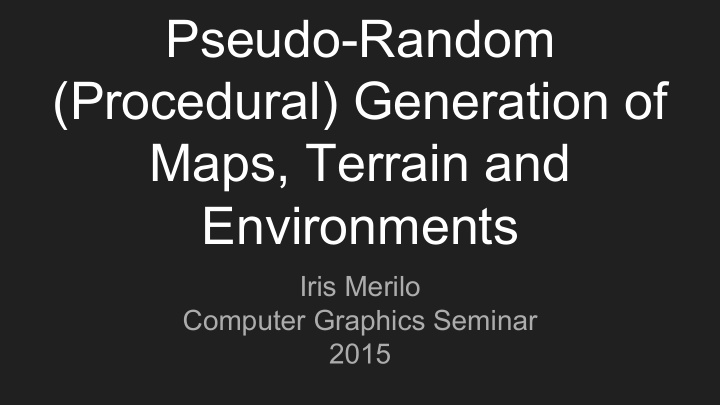



Pseudo-Random (Procedural) Generation of Maps, Terrain and Environments Iris Merilo Computer Graphics Seminar 2015
Procedural generation is primarily used by... Entertainment Industries - Computer games - saves storage space - “increases replay value” - Movies - "imperfect factory" Scientific Circles? - Models, simulations, making predictions
“Assembled” environments Grid, tile, “modular” maps… - There is a number of different “puzzle pieces” - These can be fitted together in several different ways. - It is known which pieces can be placed next to which other pieces. 4X Games Unpassable or inaccessible regions? Exploration Avoiding conflicts (one root)? Survival “Messy” outcome and glitches “Roguelikes” End of the world?
Procedural generation of “seamless” environments... What do we need said environment for? - An RTS may need a different approach than a more realistic terrain simulation, etc. - Size, limits, mapped to a sphere or a flat surface, etc. For practical purposes often still a combination of premade and generated elements (generated terrain, trees from a selection in library, etc). - Often done in a step-by-step fashion. - Seeding.
Where to start? Determine the map’s intended size and shape, generate base for heightmap Perlin Noise Simplex Noise …
Using noise as a basis for height maps - Interpret the colors as height values - Determine the color value which stands for the border between water and land. - We should now have a reasonably “random” hilly surface with water filling the low points. Problems: - May generate “undesirable” formations - Does not follow the rules of natural formation. - Homogenous
Solving the issues with noise-generated height maps Use noise in combination with other algorithms and patterns to mimic more natural and/or desired phenomena. (Voronoi diagrams, arbitrary splines, nonlinear height etc) +
Biomes and other terrain features - Assume that slopes above certain steepness won’t have foliage (or other loose items) on them? - Assign latitude, potentially calculate (approximated) currents and dominating winds. - Potentially take account of height when determining foliage. - Prevalence of rivers can be derived from latitude (or just selected biome). - Minimum length of rivers? - Assumption, that rivers will always flow down, or application of fractals?
Biomes and other terrain features continued Sand? Roads? Cities?
References https://en.wikipedia.org/wiki/Procedural_generation http://http.developer.nvidia.com/GPUGems2/gpugems2_chapter26.html http://web.mit.edu/cesium/Public/terrain.pdf http://tume-maailm.pri. ee/ylikool/ComputerGraphicsSeminar/2014/fall/slides/other/ProceduralGeneration- ManuelKramerAndMartinSchmeisser.pdf http://comserv.cs.ut. ee/forms/ati_report/downloader.php? file=3D2E85E678AB015E7EE3EE777BD6AD7A8A066631 http://www.planetside.co.uk/forums/i...0;attach=50831 http://arches.liris.cnrs.fr/publications/articles/EG2010_ProceduralGenerationOfRoads.pdf http://www-cs-students.stanford.edu/~amitp/game-programming/polygon-map-generation/
Recommend
More recommend